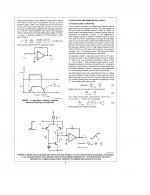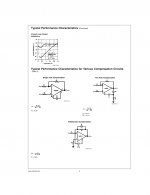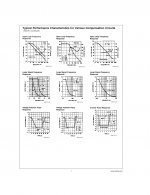There is NO compensation cap without feedback.
True; that makes it easier. But I've been building high-feedback power amps for decades with no slew rate limiting or TIM to speak of.
I'm sure you could do too if you put your mind to it.
Just don't say that you use open loop circuits to avoid SRL and TIM - that's plain $B$S.
jan
There is NO compensation cap without feedback.
Compensation cap is not the only capacitance that needs adequate current to be charged on time in an amplifier (discrete component or inherent capacitance of an active device)
George
Last edited:
Those who cannot remember the past.....
The next offshoot was to make these counters into digital voltmeters. The attempts to use a voltage controlled oscillator had the obvious problem of zero volts require a zero hertz output.
Quite a fine voltmeter was made in the 60's by dialing up the voltage using telephone relays configured as a Kelvin Varley divider with a vibrator tube chopper nulling amp. It used edge lit plastic numbers conveiniently tied to the relays for a 5 1/2 or 6 1/2 digit readout (forgot which) so no logic at all.
what are the parameters or goals that JC designs for? Lowest THD, lowest IM, lowest noise, highest dynamic range, time and temp stable, tim free, and much more.... so what circuit has ALL of these things to the best degree? How do you do so with a descrete circuit if you can not get all of them simultaneously in one IC?
-Thx RNMarsh
-Thx RNMarsh
There is NO compensation cap without feedback.
So you're saying open-loop amps can't oscillate, or at least don't sometimes need judicious application of BW limiting so they don't oscillate?
Its clear from what has been said here that IC are so expensive to fab wafers that you better have a lot of customers for it.... usually, an analog IC will be designed for a particular set of requirements and useage. Few, are designed just for audio anymore. Maybe the 5534 and a few others.
One would think that an IC opamp with stellar specs could be dropped right into an aiduo circuit and all would do well. Not so if it is an audio oscillator. I have plugged in several makes and models and some that are fantastic in the spec sheet do terrible in the oscillator circuit with high thd. Each opamp has to be used in a finely tuned circuit for that IC. Each spec on the spec sheet was generated by an optimised circuit for that spec..... you wont get all those great numbers in just one set of circuit values. It would help a lot if all spec sheets included what the design was originally developed for or is optimum for what kind of application.... just to speed the search process... rather than deducing from everyones spec sheets and even then they cant be trusted in some cases (SIM). So you still have to get them and try them or hire the designers to make a special opamp for you -- if they have the mega-funds.
This is where descrete audio falls into... custom circuit design to the particular application of phono, I/V, balanced pro line, filters or power amps in low quantity (high-end consumer) and still be economically do-able.
Thx-RNMarsh
One would think that an IC opamp with stellar specs could be dropped right into an aiduo circuit and all would do well. Not so if it is an audio oscillator. I have plugged in several makes and models and some that are fantastic in the spec sheet do terrible in the oscillator circuit with high thd. Each opamp has to be used in a finely tuned circuit for that IC. Each spec on the spec sheet was generated by an optimised circuit for that spec..... you wont get all those great numbers in just one set of circuit values. It would help a lot if all spec sheets included what the design was originally developed for or is optimum for what kind of application.... just to speed the search process... rather than deducing from everyones spec sheets and even then they cant be trusted in some cases (SIM). So you still have to get them and try them or hire the designers to make a special opamp for you -- if they have the mega-funds.
This is where descrete audio falls into... custom circuit design to the particular application of phono, I/V, balanced pro line, filters or power amps in low quantity (high-end consumer) and still be economically do-able.
Thx-RNMarsh
Last edited:
Andrew Kay (Later Kaypro computers) February 1953 as Non Linear systems is credited with the first DVM. So happy 60th birthday to the DVM!Quite a fine voltmeter was made in the 60's by dialing up the voltage using telephone relays configured as a Kelvin Varley divider with a vibrator tube chopper nulling amp. It used edge lit plastic numbers conveiniently tied to the relays for a 5 1/2 or 6 1/2 digit readout (forgot which) so no logic at all.
One thing that Bruno Putzeys, appearing here at Jan's request, made very clear to me is that there are no open loop amplifiers. Even locally degenerated stages *must* eventually have at least one pole, and all conventional stability issues still apply. It was obvious (after he said it!), but it's still a useful POV.
Thanks,
Chris
Thanks,
Chris
There is NO compensation cap without feedback.
There is no transistor without Miller capacitance.
Andrew Kay (Later Kaypro computers) February 1953 as Non Linear systems is credited with the first DVM. So happy 60th birthday to the DVM!
I owned one of those, indeed Non-Linear Systems brand. Decomissioned from the Dutch Air Force.
(hint - hint: this was mil spec stuff)
Made a lot of noise too, when stepping all those stepper relays to null the bridge.
jan
Last edited:
I owned one of those, indeed Non-Linear Systems brand. Decomissioned from the Dutch Air Force.
(hint - hint: this was mil spec stuff)
Made a lot of noise too, when stepping all those stepper relays to null the bridge.
jan
A complete "analog" of the guy in the 20's turning the knobs and using a galvanometer and standard cell.
Last edited:
Because the teacher himself, and he freely admits this, doesn't understand all the subject matter. However, he's hoping to inspire some of his students to "think outside the square", and since they've gone through a different sequence of life experiences they may come up with some new, interesting, original thinking, which furthers understanding of the matter ...A teacher who keeps telling his class that they are thick and lazy, while refusing to explain the subject matter to them but offering anecdotes instead of derivations, should not be surprised if the naughty but bright kids at the back of the class start drooling and making paper aeroplanes.
Frank
I must say that I might have a slightly different view of amplifiers and how they have changed over the many decades that I have used them.
I used to use a 1938 Gibson guitar amp, from 1958-1963, for both guitar amplification and for fm listening by adding an Eico FM tuner.
This amp was OPEN LOOP in operation, with interstage and output transformers driven by a pair of 6L6 output tubes.
You know, it sounded pretty good to me at the time, not perfect, of course.
When linear IC's were first being designed by Bob Widlar, they lacked the comp. cap that had to be added, depending on the gain setting. 30pf? Not necessarily, perhaps something smaller with a gain of 10 or 100. This was BEFORE the uA741, a part designed for SERVOS, primarily, and the uA741, given its convenience, came to dominate the entire industry. Once, we all decided that we normally wanted an internal compensation cap, then we were stuck with the lousy slew rate of the uA741 for almost all applications.
However, we could, in theory, operate its predecessors, the LM101 or the uA702 or uA709 open loop, if we wished to, at the time. Maybe somebody did, but they were NOT designed for that operation, but for global loop feedback. So when many of you were in 'grade school' we designers had to be shown WHY we had to use a dominant roll-off to avoid oscillation with global loop feedback, and this was part of the original app note explanations of these new devices.
Today, many of you have never had this 'choice' in circuit design, so you take the comp cap for granted, BUT it is the PRIMARY source for slew rate limiting. A large output load capacitor is a secondary source, and it usually does not come into play, except for vacuum tube RIAA phono preamps, or OP Amp integrators.
I used to use a 1938 Gibson guitar amp, from 1958-1963, for both guitar amplification and for fm listening by adding an Eico FM tuner.
This amp was OPEN LOOP in operation, with interstage and output transformers driven by a pair of 6L6 output tubes.
You know, it sounded pretty good to me at the time, not perfect, of course.
When linear IC's were first being designed by Bob Widlar, they lacked the comp. cap that had to be added, depending on the gain setting. 30pf? Not necessarily, perhaps something smaller with a gain of 10 or 100. This was BEFORE the uA741, a part designed for SERVOS, primarily, and the uA741, given its convenience, came to dominate the entire industry. Once, we all decided that we normally wanted an internal compensation cap, then we were stuck with the lousy slew rate of the uA741 for almost all applications.
However, we could, in theory, operate its predecessors, the LM101 or the uA702 or uA709 open loop, if we wished to, at the time. Maybe somebody did, but they were NOT designed for that operation, but for global loop feedback. So when many of you were in 'grade school' we designers had to be shown WHY we had to use a dominant roll-off to avoid oscillation with global loop feedback, and this was part of the original app note explanations of these new devices.
Today, many of you have never had this 'choice' in circuit design, so you take the comp cap for granted, BUT it is the PRIMARY source for slew rate limiting. A large output load capacitor is a secondary source, and it usually does not come into play, except for vacuum tube RIAA phono preamps, or OP Amp integrators.
Feedback IS a necessary factor to give normal slew rate limiting. The op amp is a perfect example of worst case slew rate limiting, in principle.
VFA opamps user Miller comp because its the easiest most convenient way to create an unity gain stable system with a small single monolithic cap. There is nothing worst case about it at all. And with slew rates on modern devices >15 or 20 V/us, they hare hardly going to have problems with any kind of music material in the small signal domain. And, if you are still concerned about it, you can use a CFA topology opamp.
With power amps, MIC or other 'non-slewing' comp schemes make a bit more sense if you are targeting something greater than say 100V/us but even here there is nothing to say standard MC cannot get the job done just as well. I am doing 155 V/us on my e-Amp Ovation e-Amp
- Status
- Not open for further replies.
- Home
- Member Areas
- The Lounge
- John Curl's Blowtorch preamplifier part II


